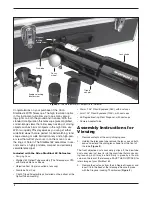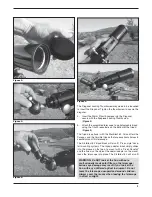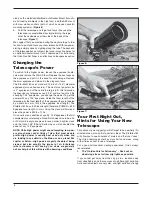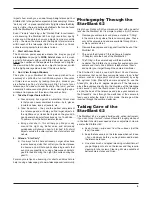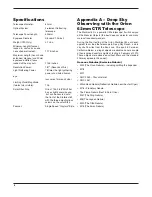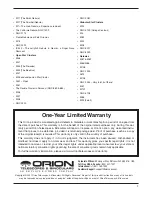
5
impacts how much you can see through
any telescope. Your
StarBlast 62 is the perfect companion to take camping! From a
“dark sky site” – a place remote from city lights where the Milky
way is visible – there are hundreds of objects that can be found
with the StarBlast 62 – See Appendix A
Even if “remote “observing is the “Golden Rule” for astronomi-
cal observing, the StarBlast 62 has high resolution, quality
optics and will be able to show you objects from near or within
a city – the moon, the planets and the brighter star clusters are
within reach of this telescope. Refer to a star chart or Orion’s
online learning center to learn where to look.
2. Start with Low Power
The 20mm low power eyepiece means the images you get
are
brighter and you get a WIDE field of view, so it is much
easier to find objects with your StarBlast 62 at low power. The
bigger the number on the eyepiece the sharper and brighter
the view will be. After you locate an object in low power, switch
to the high power eyepiece to see if the view is better.
3. Don’t View through Windows
The optics in your StarBlast 62 have been polished to an
accuracy of a millionth of an inch. Window glass is thousands
of times less accurate; by looking through a window, you
are effectively putting a “distorting warp filter” in front of your
telescope, and views will never be sharp. That said, you can
accomplish some casual daytime or lunar viewing through a
window at low power, but the view will never be sharp.
4. Take the Proper Tools with You
a. Dress warmly, if you go out in wintertime; Orion’s view
is that you can never overdress in winter – hats, gloves,
insulated shoes, layers of jackets, etc.
b. Take binoculars – they are the perfect complement
to a telescope and will help you find larger objects in
the nighttime sky or terrestrial targets on the ground. A
good general binocular for astronomy is a 10x50 size –
10 power and with 50mm diameter lenses.
c. Bring a star chart – this will help you find your way
around the night sky. Better ones, and astronomy
guidebooks will show you how to “star hop” to find faint
objects outside the solar system like star clusters and
nebula.
4. Attend a “Star Party”
d. It’s always fun to share astronomy. Larger cities have
local astronomy clubs that will tell you the best places
to observe and will hold public observing events that
can give you great tips on using a telescope and what’s
good to look at during the night (this varies during the
year!!!).
For many more tips on observing, star charts, and much more
help in using a telescope, go to www.telescope.com/community.
Photography Through the
StarBlast 62
Single Lens Reflex
or SLR cameras work best with a powerful
lens like the StarBlast 62. It is simple to attach a SLR Camera:
5. Remove you camera lens and place a standard “T-Ring”
in the camera body where the lens normally goes. These
vary with camera brand and are available through Orion
or many camera stores.
6. Remove the eyepiece and diagonal from the back of the
StarBlast 62.
7. Thread on the Standard T-thread Camera Adapter
(T-Adapter) onto the back of the StarBlast 62.
8. The T-Ring in the camera body will thread onto the
t-adapter. The StarBlast is now directly coupled onto your
camera and it acts like a 520mm telephoto lens! Focus
and center your target through the camera viewfinder.
The Starblast 62 can be used with
Smart Phone Cameras
and cameras that do not have removable lenses (non-“reflex”
camera, such as simple point and shoot cameras) by using
the optional Orion SteadyPix camera adapter. To use the
SteadyPix, take the 45 degree diagonal off the telescope,
place the eyepiece directly into the drawtube of the telescope
and secure it with the thumbscrew. Clamp the SteadyPix
around the back of the telescope and place your camera on
the SteadyPix. Look through the viewfinder of the camera to
focus and center the target; in this mode, the image will be
inverted through the camera viewfinder.
Taking Care of the
StarBlast 62
The StarBlast 62 is a ruggedly build quality, optical instrument;
if you don’t drop it or toss it around/handle it roughly while out
in the field it should never need service or adjustment. How to
care for the StarBlast 62:
a. Keep it clean – wipe dust from the surfaces (not the
lens) if needed.
b. Keep the lens covers on the telescope when not in use
– if you do always do this, you may never need to clean
the telescope lenses.
c. Use a lens brush and optical cleaning solution/tissue if
you get fingerprints, etc. on the lenses and they require
cleaning for sharp views. Cleaning kits are available at
better camera stores and Orion.


